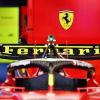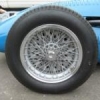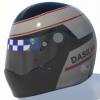Pirelli Tyres, are they too hard?
#1

Posted 16 September 2024 - 07:42
The Hard Component in Baku could have lasted the whole race if it was allowed. Monza also 1 stoppers won the race.
They are way too hard in most races, favouring 1 stop Strategy.
Advertisement
#2

Posted 16 September 2024 - 07:44
#3

Posted 16 September 2024 - 07:49
#4

Posted 16 September 2024 - 07:55
There should always be a tyre option which is durable enough to allow you to do the race non stop, sadly that is not allowed currently
#5

Posted 16 September 2024 - 07:56
In my opinion there are multi factors all equally responsible:
1. FOM's request are very hard. They want a tyre that allows the driver to push, but that also degrades to allow multiple strategies.
2. The team will always push the tyre to the limits, and if they find a risky way of getting more performance at the expense of Pirelli's suggestions they will always pick performance over safety. Pirelli has to be conservative to protect their image and to protect the teams from themselves.
3. Pirelli is a single tyre supplier so as long as they tyres are structurally safe there is no incentive for them to invest a ton of money in R&D.
It's hard to make everyone happy under the current setup.
Edited by Joseki, 16 September 2024 - 07:57.
#6

Posted 16 September 2024 - 07:59
#7

Posted 16 September 2024 - 08:04
Comment in here: "I’ve heard a lot of frustration & confusion about the tires this year from multiple people from multiple teams.
The one thing I keep hearing is that Pirelli’s guidelines are never anywhere near been correct & that on multiple occasions teams have been handed Saturday or sometimes even Sunday morning curveballs in terms of changes to guidelines that has made or broken the race for them given how they aren’t able to make changes under parc ferme conditions.
In the past even when the Pirelli’s were at there most extreme in 2012 teams knew what sort of performance was possible with each compound but this year it’s been unusually random to the point where you can build your race around Friday/Saturday running showing a certain compound will or won’t perform only to find out performance is not only different but so far outside of what is expected that it may as well be a completely different tire.
It’s to the point where there is a bit of a conspiracy theory doing the rounds suggesting that Pirelli are been encouraged to change the tire guidelines Sunday morning purely to benefit the show because of just how unusual the differences can be at times."
#8

Posted 16 September 2024 - 09:06
They are way too hard in most races, favouring 1 stop Strategy.
Which led to brilliant racing on track instead of a tiresome game of guesswork.
#9

Posted 16 September 2024 - 09:08
They are almost as inflated as road car tires these days.
#10

Posted 16 September 2024 - 09:53
There should always be a tyre option which is durable enough to allow you to do the race non stop, sadly that is not allowed currently
The tyre rule needs changing.
If you stop, you must use two different compounds. You can also have the option of doing no stops at all during the race.
#11

Posted 16 September 2024 - 10:49
#12

Posted 16 September 2024 - 12:14
The problem is accessing the performance of the tyre is too difficult. Seems to have a very narrow window to get peak performance. That peak window needs to be removed, flattened and elongated.
Its beyond Pirellis capabilities tbh, they should have just given the contract to Bridgestone just recently.
#13

Posted 18 September 2024 - 10:30
They are too soft.
Hard tyres are slippy, less grip, and drivers can push.
Soft tyres are made of paper, but more grippy, can corner faster with driver less skill needed.
When the drivers manage to make pirellis last, its because they doing a degree of tyre management the entire race, this is why you see e.g. they can pull fastest laps on a new set about 2s faster than race pace, sometimes they even do this on an old set right at end, they going nowhere near the limit the entire race.
In short they driving to a delta, they deviate from the delta somewhat on wheel to wheel but they still wont push with freedom.
Now you might say "well drivers say they at the limit they cant go faster", thats because they driving in a way to maximise tyre life, they could drive quali style, take different lines, brake differently etc. but tyres would get wrecked.
I expect if they pushed all the time, softs would be done under 5 laps, and hards within about 10-15 laps.
If you want drivers to have to do pit stops, the better solution is harder tyres combined with refuelling.
Edited by chrcol, 18 September 2024 - 10:35.
#14

Posted 18 September 2024 - 11:03
Even worse, the grip is thermal based, so they overheat within a lap, making them nigh on unusable.
#15

Posted 18 September 2024 - 12:22
If anything I think they are too soft. The hard tyre is supposed to be low grip and slow, but durable. At most races the Hard is actually very competitive.
Softer tyres wouldn't work at most tracks, even if the range allowed it. The C5 was useless at Baku apart from Qualifying and the Medium didn't have enough range to be a good hard.
Perhaps a better tyre combination for Baku would have been C5 (Q), C4 (the 'Softer' race tyre) and C1/C2 (the 'Hard but slow' tyre).
As others have said, PSI is a huge issue.
#16

Posted 18 September 2024 - 14:14
5 compounds for 24 races is just bizarre.
You end up with the same tires at Monaco and Monza. That's just BIZARRE.
There should be at least 8-9 compunds for the whole season. Teams should play with them freely including fronts/rears and lefts/rights of different compounds.
Edited by rodlamas, 18 September 2024 - 14:15.
#17

Posted 18 September 2024 - 14:26
If anything I think they are too soft. The hard tyre is supposed to be low grip and slow, but durable. At most races the Hard is actually very competitive.
Softer tyres wouldn't work at most tracks, even if the range allowed it. The C5 was useless at Baku apart from Qualifying and the Medium didn't have enough range to be a good hard.
Perhaps a better tyre combination for Baku would have been C5 (Q), C4 (the 'Softer' race tyre) and C1/C2 (the 'Hard but slow' tyre).
As others have said, PSI is a huge issue.
+1. When the Hard tire has the same speed as the medium tire, something is wrong.
5 compounds for 24 races is just bizarre.
You end up with the same tires at Monaco and Monza. That's just BIZARRE.
There should be at least 8-9 compunds for the whole season. Teams should play with them freely including fronts/rears and lefts/rights of different compounds.
+1. This sport would look so different if Pirelli could design tires for each circuit.
#18

Posted 18 September 2024 - 15:37
+1. This sport would look so different if Pirelli could design tires for each circuit.
I thought it was a competition of who can build the fastest car for a 300km race and I don't think tyres should be the solution to engineers' problems. On the contrary, I would like to have a single hard tyre for all seasons, so we can see who can build a car for that situation.
#19

Posted 18 September 2024 - 15:46
I also don't like all this tyre saving from qualifying to the race. Have separate allocations.
But generally tyres shouldn't be used for "the show". One hard compound of tyre would shut that nonsense down straight away.
Advertisement
#20

Posted 18 September 2024 - 16:10
Isn't the problem with these Pirelli tyres the thermal degradation? Get them too hot and they are basically done. Makes it so that drivers are too cautious about racing opponents unless its critical for their race.
#21

Posted 18 September 2024 - 19:29
Bridgestone only had four compounds between 2007 and 2010. Worked fine. Pirelli also had only four compounds until 2016.5 compounds for 24 races is just bizarre.
You end up with the same tires at Monaco and Monza. That's just BIZARRE.
There should be at least 8-9 compunds for the whole season. Teams should play with them freely including fronts/rears and lefts/rights of different compounds.
The problem is having three dry compounds to choose from. Two works much better from a strategic point of view, especially when there's an "unfavourable" compound that you're forced to run e.g. Button delicately balancing his Super Softs, Australia 2009 final stint. We also see similar in F2, Indycar, etc. It's the norm!
Think of Pirelli's first 5 years in F1, there was a huge pace difference between different compounds. Think of Hamilton saving a set of Softs, China 2011, and then using their inherent grip to slice through the field and win.
The problem now is the tyres are not grip limited, they are temperature limited like you wouldn't imagine. One tiny, imperceptible slide sends them through the roof. And this is because of the pressures, which are embarrassingly high to ensure the tyres do not blow up and hurt Pirelli's marketing image.
Personally I think tyre failures are part of racing and race strategy, but with every other facet of unreliability they have been engineered out of the sport.
Think about it, the less pressure in the tyres, the more flexible and malleable the rubber, which means they can take a bit of pain from the driver pushing, but they're also slightly more vulnerable due to this flexibility. The higher the pressure goes they just become more and more brittle in terms of temperature management.
I can't wait for Qatar this year, maybe we will breach the unthinkable 30psi mark.
Edited by TomNokoe, 18 September 2024 - 20:01.
#22

Posted 18 September 2024 - 21:22
Bridgestone only had four compounds between 2007 and 2010. Worked fine. Pirelli also had only four compounds until 2016.
The problem is having three dry compounds to choose from. Two works much better from a strategic point of view, especially when there's an "unfavourable" compound that you're forced to run e.g. Button delicately balancing his Super Softs, Australia 2009 final stint. We also see similar in F2, Indycar, etc. It's the norm!
Think of Pirelli's first 5 years in F1, there was a huge pace difference between different compounds. Think of Hamilton saving a set of Softs, China 2011, and then using their inherent grip to slice through the field and win.
The problem now is the tyres are not grip limited, they are temperature limited like you wouldn't imagine. One tiny, imperceptible slide sends them through the roof. And this is because of the pressures, which are embarrassingly high to ensure the tyres do not blow up and hurt Pirelli's marketing image.
Personally I think tyre failures are part of racing and race strategy, but with every other facet of unreliability they have been engineered out of the sport.
Think about it, the less pressure in the tyres, the more flexible and malleable the rubber, which means they can take a bit of pain from the driver pushing, but they're also slightly more vulnerable due to this flexibility. The higher the pressure goes they just become more and more brittle in terms of temperature management.
I can't wait for Qatar this year, maybe we will breach the unthinkable 30psi mark.
It’s ridiculous at this point.
#23

Posted 19 September 2024 - 08:16
I guess 30psi means little to me when what I work on has front pressures of 120psi and rears at 116psi.
#24

Posted 19 September 2024 - 08:26
The more I think about it, I think they should really look into doing the following:
- Keep the three tyre rule but make one of the compounds the outright Qualifying tyre. C5 for street circuits for example. This tyre needs to be so soft that it's unsuitable for the main GP.
- Always mandate the C1 as the 'Hard' tyre. It's slow. SO slow. But it's durable.
- Make the 'medium' (i.e. the softer of the usable race tyres) at least two steps below that.
Some examples of how this could work:
Silverstone: C4 (Q), C3 (M) and C1 (H). Currently the choices is C3,4 and 5.
Monaco / Baku / Singapore: C5 (Q), C4 (M) and C1 (H). Currently the choices are C3-5.
Spa: C4 (Q), C3 (M) and C1 (H).
This would ensure that the Hard tyre at each venue was truly low grip but provided range. There would be a clearly obvious good race tyre so the rule to use two compounds would ensure at least one stint on a slow tyre.
Basically what I'm asking for is at least one extra step between the M and H.
#25

Posted 19 September 2024 - 09:48
I thought it was a competition of who can build the fastest car for a 300km race and I don't think tyres should be the solution to engineers' problems. On the contrary, I would like to have a single hard tyre for all seasons, so we can see who can build a car for that situation.
F1 doesn't want a tire war, but it is a bit ridiculous we have free choice in most parts, but the tires are mandated. Very anti-competition.
Bridgestone only had four compounds between 2007 and 2010. Worked fine. Pirelli also had only four compounds until 2016.
The problem is having three dry compounds to choose from. Two works much better from a strategic point of view, especially when there's an "unfavourable" compound that you're forced to run e.g. Button delicately balancing his Super Softs, Australia 2009 final stint. We also see similar in F2, Indycar, etc. It's the norm!
Think of Pirelli's first 5 years in F1, there was a huge pace difference between different compounds. Think of Hamilton saving a set of Softs, China 2011, and then using their inherent grip to slice through the field and win.
The problem now is the tyres are not grip limited, they are temperature limited like you wouldn't imagine. One tiny, imperceptible slide sends them through the roof. And this is because of the pressures, which are embarrassingly high to ensure the tyres do not blow up and hurt Pirelli's marketing image.
Personally I think tyre failures are part of racing and race strategy, but with every other facet of unreliability they have been engineered out of the sport.
Think about it, the less pressure in the tyres, the more flexible and malleable the rubber, which means they can take a bit of pain from the driver pushing, but they're also slightly more vulnerable due to this flexibility. The higher the pressure goes they just become more and more brittle in terms of temperature management.
I can't wait for Qatar this year, maybe we will breach the unthinkable 30psi mark.
Teams had a free choice of tire compounds a couple of seasons until the pandemic made an end to that. It never returned.
But I don't remember those races fondly when drivers were toe-tipping around to keep the tires somewhat alive. In Indycar, there are also some races the option tire is way too soft and only lasts about 2 laps. For me, there is no fun in that.
#26

Posted 22 September 2024 - 13:04
In my opinion a disgrace
#27

Posted 22 September 2024 - 15:13
I bet the soft could have lasted 40 laps today.
In my opinion a disgrace
Cars were 6-8s of quali pace. Way too soft.
#28

Posted 22 September 2024 - 15:18
The more I think about it, I think they should really look into doing the following:
- Keep the three tyre rule but make one of the compounds the outright Qualifying tyre. C5 for street circuits for example. This tyre needs to be so soft that it's unsuitable for the main GP.
- Always mandate the C1 as the 'Hard' tyre. It's slow. SO slow. But it's durable.
- Make the 'medium' (i.e. the softer of the usable race tyres) at least two steps below that.
Some examples of how this could work:
Silverstone: C4 (Q), C3 (M) and C1 (H). Currently the choices is C3,4 and 5.
Monaco / Baku / Singapore: C5 (Q), C4 (M) and C1 (H). Currently the choices are C3-5.
Spa: C4 (Q), C3 (M) and C1 (H).
This would ensure that the Hard tyre at each venue was truly low grip but provided range. There would be a clearly obvious good race tyre so the rule to use two compounds would ensure at least one stint on a slow tyre.
Basically what I'm asking for is at least one extra step between the M and H.
Problem with this is that a slow tyre with high range is easily negated by an extra stop
#29

Posted 22 September 2024 - 15:44
#30

Posted 22 September 2024 - 15:45
Problem with this is that a slow tyre with high range is easily negated by an extra stop
That's the point!
#31

Posted 22 September 2024 - 15:50
Problem with this is that a slow tyre with high range is easily negated by an extra stop
That's the point. Multi stop GP or a one stopper on durable but slow rubber.
#32

Posted 22 September 2024 - 16:28
Problem with this is that a slow tyre with high range is easily negated by an extra stop
Which can be partially solved by solving one of F1's other problems ... simply restrict the number of mechanics that are allowed to be outside during a pit stop to, say, 3.
#33

Posted 23 September 2024 - 18:01
Pirelli probably has an impossible task. So, I don't see the value of maintaining the status quo of a single tire supplier when there can be multiple suppliers and the governing body can set a performance target and homologate the entire supply. The supposed reason for the single supplier as stated by Pirelli was to prevent competition between suppliers opting for max performance over safety and to keep costs down. Oddly enough in a BoP era of motorsport, this rationale seems antiquated. Give teams an option to run different tires that are homologated and one joker per season to switch supplies or whatever. We know Bridgestone was interested in supplying tires. I think it's time to open things up.
#34

Posted 23 September 2024 - 18:05
different suppliers will mean a big part of the grid will be on the wrong tyres. So the right supplier would give a huge advantage.
Why would we want that? In a no testing formula, how will that work?
We have so many teams fighting for wins.
Why fix anything?
#35

Posted 23 September 2024 - 18:08
They are just low quality tyres, nothing else.
#36

Posted 23 September 2024 - 18:11
Problem with this is that a slow tyre with high range is easily negated by an extra stop
Well it depends, on some tracks the laptimes converge pretty quickly between either different compounds or different tire age, so it get’s pretty difficult to negate that extra stop.
Edited by peroa, 23 September 2024 - 18:37.
#37

Posted 23 September 2024 - 18:18
different suppliers will mean a big part of the grid will be on the wrong tyres. So the right supplier would give a huge advantage.
Why would we want that? In a no testing formula, how will that work?
We have so many teams fighting for wins.
Why fix anything?
In the budget era, allow additional testing. We are seeing team get the tires wrong now. We see teams design cars that are incompatible with how the current tire operates and take months to bring updates. Nevertheless, if tire supply with multiple suppliers is homologated there is already a prescribed profile for teams to target. So, I would not see it as being on the wrong tire, just a different tire. More flexibility either side of spectrum, but more flexibility nonetheless.
EDIT: Additional thoughts. For the record, I have enjoyed the racing overall in this generation of car/tire combination. However, specifically speaking on the tires, I think there is a better way to manage all of it which includes having multiple suppliers...which does not necessarily mean just having 2.
Edited by Secretariat, 23 September 2024 - 18:45.
#38

Posted 23 September 2024 - 20:30
In the budget era, allow additional testing. We are seeing team get the tires wrong now. We see teams design cars that are incompatible with how the current tire operates and take months to bring updates. Nevertheless, if tire supply with multiple suppliers is homologated there is already a prescribed profile for teams to target. So, I would not see it as being on the wrong tire, just a different tire. More flexibility either side of spectrum, but more flexibility nonetheless.
EDIT: Additional thoughts. For the record, I have enjoyed the racing overall in this generation of car/tire combination. However, specifically speaking on the tires, I think there is a better way to manage all of it which includes having multiple suppliers...which does not necessarily mean just having 2.
Thanks for the reply and context.
Tyres are, by far, the most important thing on a car. Now we have 20 teams with access to the same tyres, and some get it wrong. But it's essentially the same tyre.
We have a very tight grid, sometimes going up to 16th place or lower within 1 second. That's mad in a good way.
I feel putting half of the grid on a different tyre will just mean we have one half competitive the other one not. Maybe next weekend the other way? or maybe not.
I did not enjoy particularly the tyre war era of the 00s. Bridgestone built tyres for Ferrari only, making everyone move away. Then in 2005 the Bridgestone was just awful robbing us of a 3 way fight to the tile (imaging Alonso, Kimi and Michael going for it).
in the era of perfection as we are today being on a tyre that's half a second a lap slower just because can mean half of the grid doesn't stand a chance
#39

Posted 24 September 2024 - 00:44
Don’t quit your day jobI bet the soft could have lasted 40 laps today.
In my opinion a disgrace
Advertisement
#40

Posted 24 September 2024 - 04:01
I recall the weird season 2005?, where there was no tyre changing allowed during he race except for punctures or wet weather.. It caused a massive issue at the US Grand Prix with the Michelin runners unable to take part because the tyres were likely to explode on the high speed banking.
#41

Posted 24 September 2024 - 07:40
I really like the idea that at some circuits the softest tyres will last a long time and ant others the hardest tyres need replacing. It actually introduces strategy variance throughout the season. Far too many races have been predictable one stoppers lately.I bet the soft could have lasted 40 laps today.
In my opinion a disgrace
#42

Posted 24 September 2024 - 10:54
Thanks for the reply and context.
Tyres are, by far, the most important thing on a car. Now we have 20 teams with access to the same tyres, and some get it wrong. But it's essentially the same tyre.
We have a very tight grid, sometimes going up to 16th place or lower within 1 second. That's mad in a good way.
I feel putting half of the grid on a different tyre will just mean we have one half competitive the other one not. Maybe next weekend the other way? or maybe not.
I did not enjoy particularly the tyre war era of the 00s. Bridgestone built tyres for Ferrari only, making everyone move away. Then in 2005 the Bridgestone was just awful robbing us of a 3 way fight to the tile (imaging Alonso, Kimi and Michael going for it).
in the era of perfection as we are today being on a tyre that's half a second a lap slower just because can mean half of the grid doesn't stand a chance
All fair. I will say I think the difference between the tire war in that era and what I think is possible now, is that in that era Michelin and Bridgestone were producing grooved slicks that to my memory was a unique tire that did not exist competitively anywhere else in motorsport. If one of them got it wrong, no where else to look how to fix it. Given that now there seems to be overlap with the kinds of slick tires, wheel sizes in motorsports (e.g. Alonso has stated his time in WEC helped when his re-acclimatization in F1/tires F1 changed wheel sizes) there are a lot directions the series can go. Nevertheless, I do understand the rationale for the current formula as it is the same challenge for everyone to get on top of.
Edited by Secretariat, 24 September 2024 - 11:24.
#43

Posted 24 September 2024 - 11:11
I really like the idea that at some circuits the softest tyres will last a long time and ant others the hardest tyres need replacing. It actually introduces strategy variance throughout the season. Far too many races have been predictable one stoppers lately.
It doesn't help the teams can't select their own tires. Pre 2020, we had more variances in teams choosing hards over mediums, etc. Now everyone saves 1-2 MH sets.
#44

Posted 24 September 2024 - 11:15
It doesn't help the teams can't select their own tires. Pre 2020, we had more variances in teams choosing hards over mediums, etc. Now everyone saves 1-2 MH sets.
Even then they didn't choose the compounds, just the number of sets of each.
#45

Posted 20 October 2024 - 19:58
#46

Posted 20 October 2024 - 20:08
1 Stopp race for every race now
And drivers can push. You know, the thing that everyone is always asking for.
#47

Posted 02 December 2024 - 10:03
So, Albon and both AT's stopped with ~17 to go and a SC to run for softs. While the Mediums lasted 34 laps, the softs could barely hang on to 7. It has been a while now the soft was used as a race tire bar the fastest lap. There was a time the hard tire was unusable, but these days the soft only has a place at the Monaco start.
#48

Posted 02 December 2024 - 18:16
They should just have one slick tyre compound. The challenge is to design and build the best car, not how to choose and manage the tyres that they do not design or manufacture.

































